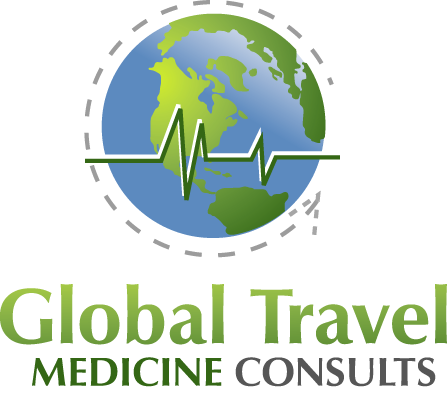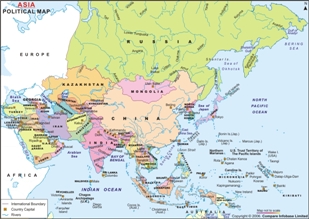Travel Medicine Vaccine and Immunization Information for Countries in Asia
Travel Medicine Immunization and Vaccine requirements in East Asia, South Asia, and Southeast Asia vary from region to region. However, there are some General Guidelines for vaccines such as the Yellow Fever Vaccination, Malaria, and other vaccines which are outlined below.
Travel Medicine Immunization and Vaccine requirements in Africa vary. However, there are some General Guidelines for vaccines such as the Yellow Fever Vaccination, Typhoid, Malaria, and other vaccines which are outlined below.
Please click on the Links below for each individual country you will be traveling in within Asia to view the specific travel medicine requirements:
East Asia
South Asia
The Middle East and former USSR Countries
Southeast Asia
General Health Information for Travelers to Countries in East Asia, South Asia, and South East Asia
Recommended Vaccinations and Preventive Medications:
* Hepatitis A or immune globulin (IG).
* Hepatitis B, especially if you might be exposed to blood or body fluids (for example, health-care workers), have sexual contact with the local population, or be exposed through medical treatment.
* Japanese encephalitis, if you plan to visit rural farming areas and under special circumstances, such as a known outbreak of Japanese encephalitis.
* Malaria: your risk of malaria may be high in some of the countries in these regions. See your health care provider for a prescription antimalarial drug.
* Rabies, if you might have extensive unprotected outdoor exposure in rural areas, such as might occur during camping, hiking, or bicycling, or engaging in certain occupational activities.
* Typhoid, particularly if you are visiting developing countries in this region. Vaccination is particularly important because of the presence of S. Typhi strains resistant to multiple antibiotics in the South Asia region.
* TAs needed, booster doses for Tetanus-Diphtheria and Measles. A one-time dose of Polio for adults is recommended for some countries in the Southeast Asia Region.
Diseases found in East Asia, South Asia, and Southeast Asia (risk can vary by country and region within a country; quality of in-country surveillance also varies)
The preventive measures you need to take while traveling in East Asia, South Asia, and Southeast Asia depend on the areas you visit and the length of time you stay. You should observe the precautions listed in this document in most areas of this region.
East Asia:
In highly developed areas of Japan, Hong Kong, South Korea, and Taiwan, you should observe health precautions similar to those that would apply while traveling in the United States.
Malaria:
Malaria is always a serious disease and may be a deadly illness. Humans get malaria from the bite of a mosquito infected with the parasite. Prevent this serious disease by seeing your health care provider for a prescription antimalarial drug and by protecting yourself against mosquito bites.
East Asia:
Travelers to some areas in China, North Korea, and South Korea may be at risk for malaria. Travelers to malaria-risk areas in China, North Korea, and South Korea should take an antimalarial drug.
There is no risk of malaria in Japan, Taiwan, Hong Kong S.A.R. (China), Macau S.A.R. (China), and Mongolia.
South Asia:
Travelers to malaria-risk areas, including infants, children, and former residents of the Indian Subcontinent, should take an antimalarial drug. Prevent this serious disease by seeing your health care provider for a prescription antimalarial drug and by protecting yourself against mosquito bites.
Southeast Asia:
Your risk of malaria may be high in some of the countries in this region. Travelers to malaria-risk areas, including infants, children, and former residents of Southeast Asia, should take an antimalarial drug. There is no malaria risk in Singapore and Brunei.
Yellow Fever:
East Asia:
There is no risk for Yellow Fever in East Asia. A certificate of yellow fever vaccination may be required for entry into certain of these countries if you are coming from countries in South America or sub-Saharan Africa.
South Asia:
There is no risk for Yellow Fever in the Indian Subcontinent. A certificate of yellow fever vaccination may be required for entry into certain of these countries if you are coming from countries in South America or sub-Saharan Africa.
South East Asia:
There is no risk for Yellow Fever in Southeast Asia. A certificate of yellow fever vaccination may be required for entry into certain of these countries if you are coming from countries in South America or sub-Saharan Africa.
Food and Waterborne Diseases:
Make sure your food and drinking water are safe. Food and waterborne diseases are the primary cause of illness in travelers. Travelers' Diarrhea can be caused by viruses, bacteria, or parasites, which are found throughout East Asia, South Asia, and Southeast Asia and can contaminate food or water. Infections may cause diarrhea and vomiting (E. coli, Salmonella, Cholera, and Parasites), fever (Typhoid Fever and Toxoplasmosis), or liver damage (Hepatitis).
Other Disease Risks :
East Asia:
Dengue, Filariasis, Japanese Encephalitis, and Plague are diseases carried by insects that also occur in these regions. Protecting yourself against insect bites will help to prevent these diseases. Avian Influenza is also present throughout these regions including China. Polio has resurfaced in Indonesia.
Outbreaks of Severe Acute Pulmonary Syndrome (SARS) occurred in mainland China, Hong Kong, and Taiwan in 2003.
If you visit the Himalayan Mountains, ascend gradually to allow time for your body to adjust to the high altitude, which can cause insomnia, headaches, nausea, and altitude sickness. In addition, use sunblock rated at least SPF 15, because the risk of sunburn is greater at high altitudes.
South Asia:
Filariasis is common in Bangladesh, India, and the southwestern coastal belt of Sri Lanka. A sharp rise in the incidence of visceral Leishmaniasis has been observed in Bangladesh, India, and Nepal. In Pakistan, it is mainly reported from the north (Baltisan). Cutaneous Leishmaniasis occurs in Afghanistan, India (Rajasthan), and Pakistan. Outbreaks of Dengue Fever can occur in Bangladesh, India, Pakistan, and Sri Lanka, and the hemorrhagic form has been reported from eastern India and Sri Lanka. Japanese Encephalitis occurs widely except in mountainous areas. Protecting yourself against insect bites will help to prevent these diseases.
Polio is still endemic in India and Afghanistan. Rabies is common in the region and poses a risk to travelers, especially to rural areas.
Leptospirosis, a bacterial infection often contracted through recreational water activities in contaminated water is common in tropical areas of this region.
If you visit the Himalayan Mountains, ascend gradually to allow time for your body to adjust to the high altitude, which can cause insomnia, headaches, nausea, and altitude sickness. In addition, use sunblock rated at least 15 SPF, because the risk of sunburn is greater at high altitudes.
Southeast Asia:
Dengue, Filariasis, Japanese Encephalitis, and Plague are diseases carried by insects that also occur in this region. Protecting yourself against insect bites will help to prevent these diseases. Avian influenza is also present throughout this region. Polio has resurfaced in Indonesia. Rabies is common in the region and poses a risk to travelers, especially to rural areas.
Do not swim in fresh water (except in well-chlorinated swimming pools) in certain areas of Cambodia, Indonesia, Laos, Philippines, and Thailand to avoid infection with Schistosomiasis, Leptospirosis, a bacterial infection often contracted through recreational water activities in contaminated water, such as kayaking, is common in tropical areas of this region. An outbreak was reported among expedition travelers in 2000.
About Us:
We are Travel Medicine Board Certified Physicians and Doctors. We provide: Yellow Fever, Typhoid, Hepatitis A, Hepatitis B, Diphteria, Tetanus, Pertussis, Meningitis, Hemophilus B, Rabies, Japanese Encephalitis Virus, Mumps Measles and Rubella (MMR), HPV (Gardasil), Rota Virus, Varicella, Polio and Influenza Vaccines to Residents of Washington DC, Maryland and Virginia.
Our Vaccines Clinic is located in the Washington DC Metro area.




